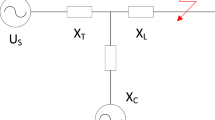Abstract
In recent years a revival of rotating synchronous condensers could be seen all over the world. This trend is mainly driven by the introduction of enduring energy production. The change in energy mix is leading to the replacement of conventional energy production with synchronous machines by “low inertia” and “low thermal time constant” power park modules. Power park modules are represented by wind farms and registrable solar power plants. Compared to power park modules synchronous machines have a high thermal time constant and must therefore not be limited during short circuit events in its reactive power capability. Additionally, synchronous condensers have a natural mechanical inertia, which cannot be reached by modern power park modules. Therefore synchronous condensers complement power park modules for transmission upgrade projects and help to improve reliability, preserve future energy options and contribute to economic stability. Different design considerations are discussed.
Zusammenfassung
In letzter Zeit ist weltweit eine Wiederbelebung der rotierenden Phasenschieber zu erkennen. Dieser Trend ist auf den verstärkten Einsatz nachhaltiger Energieerzeugung zurückzuführen. Der Einsatz neuer Energieformen führt zur Verdrängung konventioneller Erzeugung mit Synchronmaschinen durch Energieparks, welche eine vergleichsweise geringe kinetische Energie und eine kleine thermische Zeitkonstante aufweisen. Energieparks bestehen hauptsächlich aus Windkraftwerken und einer leistungsmäßig kleinen Anzahl an Solar- und anderen Kraftwerken. Energieparks haben gegenüber rotierenden Phasenschiebern eine kleine thermische Zeitkonstante, die bei Kurzschlussereignissen im Netz begrenzt werden muss. Rotierende Phasenschieber weisen eine hohe mechanische Trägheit auf, die von Energieparks nicht erreicht wird. Daher stellen rotierende Phasenschieber eine gute Ergänzung zu Energieparks dar. Dies gestattet, Energieübertragungssysteme zu erweitern, die Verfügbarkeit und Sicherheit zu erhöhen sowie für zukünftige Entwicklungen in der Energieerzeugung gerüstet zu sein. Für rotierende Phasenschieber werden Auswahl- und Designüberlegungen dargestellt.






Similar content being viewed by others
References
Abreu Lisias, V. L., Shahidehpour, M. (2006): Wind energy and power system inertia. Piscataway: IEEE Power and Engineering Society.
HATCH LTD (2010): The lower Churchill project DC1210-HVdc sensetivity studies. Final Summary Report.
IEEE421.1 (2007): IEEE standard definitions for excitation systems for synchronous machines.
IEC 60034-4 Edition 3.0 (2008): Part 4: Methods for determining synchronous machine quantities from tests IEEE guide for identification, testing, and evaluation of the dynamic performance of excitation control systems.
Marken, P. E., Depoian, A. C., Skliutas, J., Verrier, M. (2011): Modern synchronous condenser performance considerations. PESGM2011–PESGM000253.
Roger Berube, G., Hajagos, L. M. (2009): Coordination of under excitation limiters and loss of excitation relays with generator capability.
Author information
Authors and Affiliations
Corresponding author
Rights and permissions
About this article
Cite this article
Glaninger-Katschnig, A. Contribution of synchronous condensers for the energy transition. Elektrotech. Inftech. 130, 28–32 (2013). https://doi.org/10.1007/s00502-013-0119-3
Received:
Accepted:
Published:
Issue Date:
DOI: https://doi.org/10.1007/s00502-013-0119-3




